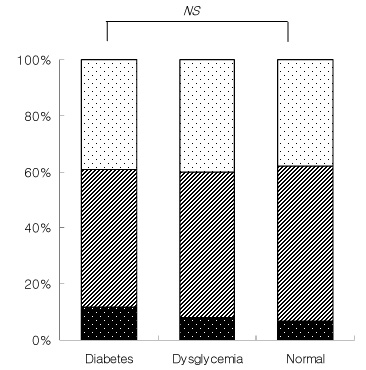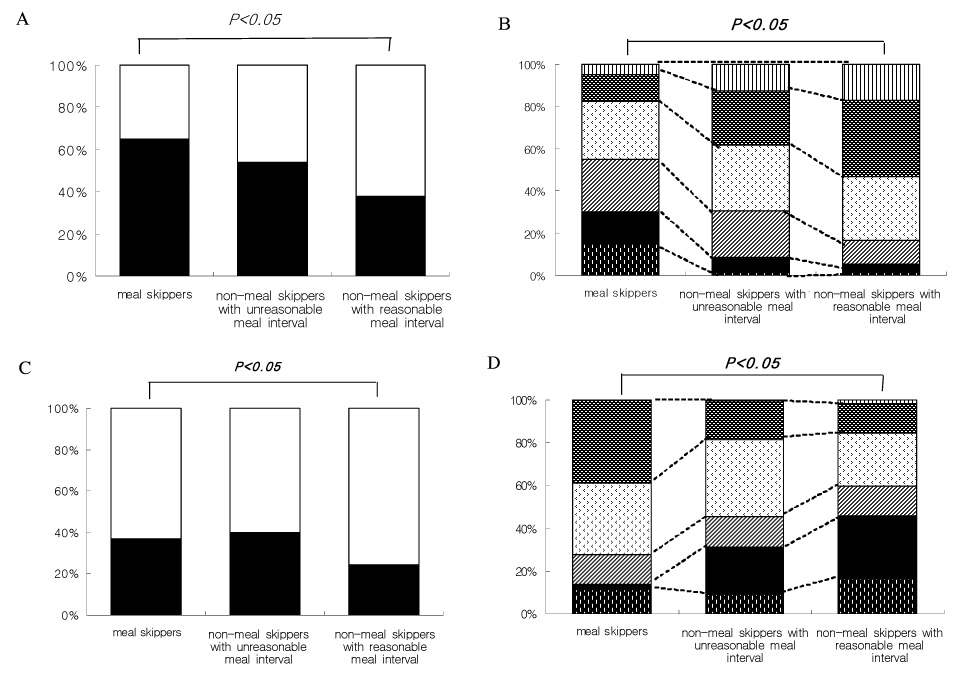Korean Diabetes J.
2008 Feb;32(1):68-76. 10.4093/kdj.2008.32.1.68.
Analysis of Meal Habits from the Viewpoint of Regularity in Korean Type 2 Diabetic Patients
- Affiliations
-
- 1Diabetes Center, Eulji Hospital, Korea.
- 2epartment of Internal Medicine, Eulji University College of Medicine, Korea.
- KMID: 2298112
- DOI: http://doi.org/10.4093/kdj.2008.32.1.68
Abstract
-
BACKGROUND: The regular meal pattern with consistent day-to-day calorie and carbohydrate intake is one of the most important determinants of good glycemic control in diabetes. This study was aimed to investigate the meal pattern and their relationships with total energy intake, nutrients intake and glycemic and lipid profile in type 2 diabetes.
METHODS
1,084 subjects were divided according to glycemic status into three groups: the diabetes (DM), dysglycemia (DG) and normal (N). The meal frequency (MF), meal interval (MI) and daily intake of total energy, macronutrient and micronutrient were estimated with the 24 hours dietary recall from the Korean National Health and Nutrition Examination Survey (KNHANES) in 2001 and Eulji hospital. For analysis of meal pattern and it's relations with the nutrients intake, we regrouped into meal skipper (G1), non-meal skipper with unreasonable MI (G2), and non-meal skipper with reasonable MI (G3).
RESULTS
17.5% of DM, 21.8% of DG, 23.3% of N skipped at least one meal a day without significant difference across the groups. 55.9% of non-meal skipper had unreasonable MI. Meal was more regular in older age, lower educated person, employee, and female. G1 took higher fat, and more calories form snack and less micronutrient density, compared with G3 (P < 0.05). HbA1c, total cholesterol and triglyceride values were higher in G1 compared with other two groups (P < 0.05).
CONCLUSION
Many type 2 diabetics had the irregular meal patterns, which was associated with poor glycemic control, lipid profiles and less micronutrient density. This suggested that another treatment strategy might be required for those who had irregular lifestyle.
MeSH Terms
Figure
Cited by 1 articles
-
Nutrients and Dish Intake by Fasting Blood Glucose Level
Jihyun Choi, Hyun-Kyung Moon
Korean J Nutr. 2010;43(5):463-474. doi: 10.4163/kjn.2010.43.5.463.
Reference
-
1. Kerver JM, Yang EJ, Obayashi S, Bianchi L, Song WO. Meal and snack patterns are associated with dietary intake of energy and nutrients in US adults. J Am Diet Assoc. 2006. 106:46–53.2. Jenkins DJ, Wolever TM, Vuksan V, Brighenti F, Cunnane SC, Rao AV, Jenkins AL, Buckley G, Patten R, Singer W. Nibbling versus gorging: metabolic advantages of increased meal frequency. N Engl J Med. 1989. 321:929–934.3. Fabry P, Fodor J, Hejl Z, Geizerova H, Balcarova O. Meal frequency and ischaemic heart-disease. Lancet. 1968. 2:190–191.4. Jenkins DJ. Carbohydrate tolerance and food frequency. Br J Nutr. 1997. 77:71–81.5. Mann J. Meal frequency and plasma lipids and lipoproteins. Br J Nutr. 1997. 77:83–90.6. Schlundt DG, Hill JO, Sbrocco T, Pope-Cordle J, Sharp T. The role of breakfast in the treatment of obesity: a randomized clinical trial. Am J Clin Nutr. 1992. 55:645–651.7. Morgan KJ, Zabik ME, Leveille GA. The role of breakfast in nutrient intake of 5- to 12-year-old children. Am J Clin Nutr. 1981. 34:1418–1427.8. Carlson O, Martin B, Stote KS, Golden E, Maudsley S, Najjar SS, Ferrucci L, Ingram DK, Longo DL, Rumpler WV, Baer DJ, Egarn J, Mattson MP. Impact of reduced meal frequency without caloric restriction on glucose regulation in healthy, normal-weight middle-aged men and women. Metabolism. 2007. 56:1729–1734.9. Stote KS, Baer DJ, Spears K, Paul DR, Harris GK, Rumpler WV, Strycula P, Najjar SS, Ferrucci L, Ingram DK, Longo DL, Mattson MP. A controlled trial of reduced meal frequency without caloric restriction in healthy, normal-weight, middle-aged adults. Am J Clin Nutr. 2007. 85:981–988.13. Ministry of health and welfare / Korea health industry development institute (MOHW/ KHIDI). 2001 National Health and Nutrition Survey report-Nutrition survey (I). 2002.14. American diabetes association. Diagnosis and classification of diabetes mellitus. Diabetes care. 2007. 20:42–47.15. Rohlfing CL, Little RR, Wiedmeyer HM, England JD, Madsen R, Harris MI, Flegal KM, Eberhardt MS, Goldstein DE. Use of GHb(HbA1c) in screening for undiagnosed diabetes in the U.S. population. Diabetes care. 2000. 23:187–191.16. Friedwald WT, Levy RI, Fredrickson DS. Estimation of the concentration of low density lipoprotein cholesterol in plasma, without use of the preparative ultracentrifuge. Clin Chem. 1972. 18:499–502.17. Williams TF, Anderson E, Watkins JD, Coyle V. Dietary errors made at home by patients with diabetes. J Am Diet Assoc. 1967. 51:19–25.18. Willett W, Stampfer MJ. Total energy intake: Implications for epidemiologic analysis. Am J Epidemiol. 1986. 124:17–27.21. Landgraf R, Frank M, Bauer C, Dieken ML. Prandial glucose regulation with repaglinide: its clinical and lifestyle impact in a large cohort of patients with type 2 diabetes. Int J Obes Relat Metab Disord. 2000. 24:38–44.29. Song WO, Chun OK, Obayashi S, Cho S, Chung CE. Is consumption of breakfast associated with body mass index in US adults? J Am Diet Assoc. 2005. 105:1373–1382.30. Ma Y, Bertone ER, Stanek EJ, Reed GW, Hebert JR, Cohen NL, Merriam PA, Ockene IS. Association between eating patterns and obesity in a free-living US adult population. Am J Epidemiol. 2003. 158:85–92.
- Full Text Links
- Actions
-
Cited
- CITED
-
- Close
- Share
- Similar articles
-
- The association between meal regularity and weight loss among women in commercial weight loss programs
- The Effects of Regular Dietary Habits on Obesity Indices and Nutrition Intakes in Adult Males
- Effect of Breakfast Consumption and Meal Time Regularity on Nutrient Intake and Cardiometabolic Health in Korean Adults
- Barriers to dietary practice adherence among the elderly diabetes
- Relationship between Meal Regularity and the Metabolic Syndrome among Korean Single-Person Household Adults under 60 Years of Age: Based on the Seventh Korea National Health and Nutrition Examination Survey (2016∼2018)



